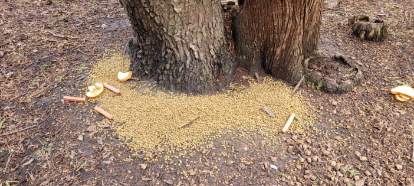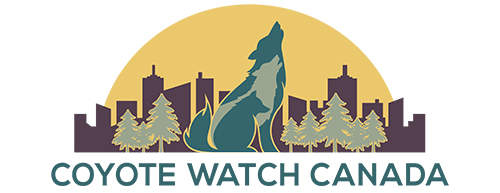Coexisting With Coyotes

Eastern coyote sightings are not uncommon throughout Ontario and across North America. This resilient species has been a vital part of our ecosystem for over a century.
By applying common sense, and preventative techniques, and being aware of the diversity of wildlife with which we share our communities, we can minimize human and wildlife encounters and conflict. Coyote sightings often increase as a result of humans intentionally or unintentionally providing a food source and people conclude they are seeing multiple coyotes when, in fact, the same coyote is making numerous visits to the same area where it has found a consistent food source.
Overflowing bird feeders, mishandled compost, and fallen fruit attract a diverse range of prey species such as rodents, squirrels, chipmunks, and insects, which coyotes will utilize as food. Consider that the birds and small mammals that frequent bird feeder stations are potential prey food for other predator species such as owls, hawks, foxes, Mustelids, and domestic pets. New infrastructure such as roads, fencing, and urbanization impacts how wildlife moves through our communities. Urban boundary expansion creates a loss of habitat and green spaces for wildlife. Canids and other wild animals must adjust to their ever-changing world and may be forced to establish new territories to hunt and forage for sustenance; dens are destroyed through development activities and the resilient coyote responds to these environmental impacts.
Seasonal behaviour that may influence an increase in coyote sightings
Winter during the mating period, courtship begins in (Jan) and mates are viable to procreate during (Feb), Spring during den selection/pup rearing (Mar- Sept), and during the dispersal of juvenile or yearling family members also affect the number of times a resident observes the same or different coyote. Each canid is an individual and s/he and each family respond uniquely to seasonal milestones. Dispersal may occur throughout a young coyote's life, once they reach maturity while others may remain in the home range over some time.
By promoting respect, compassion, and safety education throughout our community about these intelligent, adaptable keystone species, we can safely coexist with coyotes. Coyote Vocalizations are a coyote’s specialized means of communicating danger, locating pack members, defending territory, and survival skills for pups. Vocalizing acts as an effective 'canid GPS'. Their series of high-pitched yips, barks, and howls can be heard more frequently during certain times of the year. A pair of coyotes often sounds like a chorus to the inexperienced listener. This phenomenon resembles an auditory illusion, and is referred to as the 'beau geste effect'. The following study was published in Human–Wildlife Interactions 11(2):167–174, Brewster, et al., 2017 Do You Hear What I Hear? delves into this fascinating phenomenon. Our Eastern coyote vocalizations were generously provided by Lesley Sampson, Executive Director in Ontario.
Coyote family quick facts
- Coyotes are capable of breeding within the first year, however, studies have shown >2-3 years is more common.
- Gestation for the female is 60-63 days. Usually begins early to mid-February.
- In an established home-range territory, the adult monogamous pair may have litters of between two and 10 pups; the average litter size is five pups.
- Adult coyotes secure and defend their territory by frequently moving throughout the landscape.
- Vocalizing, and leaving olfactory markers in the landscape such as scat, urine, and scent markings along with soil scratching, communicate to non-related coyotes, that the land is not vacant. Family members also receive vital information from these information nodes.
- Transient, nomadic or loner coyotes respect territories that are already established.
- Coyotes co-parent and share in the pup-rearing duties. It is not uncommon for older siblings from previous litters, aunts, or uncles to help with this task. These helpers would be yearlings over a year old.
- Pups need their parents to teach them the appropriate survival life skills and nurture them as they develop and become “successful coyotes”.
- Pups, their parents, and relatives join in chorus to vocalize teaching the young effective communication techniques while building family bonds.
- Coyote (and other canid) parents are protective and caring and will not tolerate threats to their young such as a domestic dog off-leash. Dogs are considered another predator to coyotes and will respond defensively to a dog off-leash or intruding near a den or a rendezvous site.
- Spring and summer to early fall are busy seasonal milestones for all wildlife families, particularly for canids.
- As pups become more independent, both parents may venture off to hunt and forage leaving the pups behind at the den area or safe and secure rendezvous sites. Parents will bring food items and toys back for the pups. Please reconsider removing pups from wild spaces as you may be tearing a family apart. Well-meaning citizens assume that pups are orphaned when parents are foraging and hunting. Contact Coyote Watch Canada and/or your local rehabilitation expert for advice on what are the most humane and appropriate next steps.
- Use common sense when recreating outdoors. Unplug the earbuds and put the personal cells away. Respect wildlife, and wildlife-proof property. Report any feeding of coyotes, wolves, or foxes to your local City By-Law or appropriate agency. See our easy tips for the wildlife-proofing property.
A good example of a community that has implemented a no-feeding bylaw is the City of Niagara Falls, Ontario. Residents must adhere to important By-Laws for the City of Niagara Falls including the Anti Wildlife Feeding By-Law and the licensing and regulating dogs that are in place.
Helpful coexistence tips
- Never feed wildlife. Our best approach for safe and harmonious coexistence is to avoid conditioning them with food and humans. We need to ensure our inappropriate actions do not negatively influence their instincts and wariness towards humans. This is the best way to promote a safe and healthy community for people, pets, and wildlife. The few documented cases of coyote-inflicted wounds on humans occurred as a result of humans encouraging close proximity by feeding a coyote. Food rewards encourage the coyote to increase their proximity tolerance to people, yards, and public places where the food is placed.
- Keep pet food and water bowls indoors. Pet food will attract coyotes to your yard.
- Partner with local TNSR (Trap Neuter Spay Return) and Adoption organizations that promote feed/remove (food is placed and removed after 30 minutes) and home placement programs for feral cats.
- Keep trash cans covered and use wildlife-proof lids.
- Pick ripened fruit, and clean all rotted fallen fruit from the ground.
- Do not allow a large amount of wild bird seed to remain on your lawn. Birdseed attracts birds, rabbits, squirrels, and rodents, which are prey for coyotes.
- Supervise pets and keep them under strict control. Adhering to leash by-laws, accompanying pets on walks, and not allowing them to roam are in the best interests of your pets. Our pets are at risk of many environmental dangers when they are not under our control; traps, poison, vehicles, and other dogs. Birds of prey such as owls, eagles, hawks, foxes, and coyotes may prey on smaller pets. Cats are safest indoors or in secure outdoor play enclosures like a "catio". Domestic dogs can be considered competition for food items at locations where humans are feeding coyotes, and coyotes may attempt to protect or defend themselves against a domestic dog to eliminate the threat to their food, territory, or pups.
- Keep chickens, rabbits, and other small animals in covered enclosures, constructed with heavy mesh wire. Domestic dogs, coyotes, raccoons, mink, and weasels can break through chicken coop wire.
- Neutering pets is a responsible and good practice. Although a very rare occurrence, a domesticated dog may be interested in and attempt to mate with a coyote.
- Do not approach coyotes, their dens, or their pups, even if it appears the parents are not in the vicinity. Coyotes will do their best to avoid humans but may interact with humans when provoked (during risky human behaviour such as feeding, interfering with pups, or harassing) sick, or injured.
- Teach children about wildlife and how to safely respond to a coyote (or dog) nearby.
- Respect, compassion, and education are common-sense tools that nurture safe and healthy human-wildlife coexistence awareness.
What can I do if a canid frequently visits my backyard?
1) Record dates/times of sightings.
2) Check your property for wildlife attractants. Review our Wildlife Proofing Quick Tips for help! Be proactive in minimizing any food sources and ensure that all outbuildings are sealed underneath.
3) For local Niagara Falls, Ontario residents you may report any known feeding of wildlife to the City of Niagara Falls.
Lastly, if no help is available, use our National Sighting Platform: Report frequent sightings only on the City of Niagara Falls website. We may be able to point you in the right direction and support agencies.
Share our informative and educational community resource Coexisting with Wildlife with a neighbour, family, or friend! This helps in promoting facts not fear-based misconceptions and myths about canids in our midst.
Human indifference is not an appropriate response to a coyote, fox, or wolf getting comfortable around areas that people frequent. Never allow a canid to linger or bed down near your home or business. Print and follow our Wildlife Proofing Quick Tips.
Applying simple low-intensity aversion conditioning or humane hazing techniques will send a clear message to a canid that they are not welcome.
Yelling in a firm voice while outdoors “Go away coyote!”, filling a large garbage bag with air, and snapping it while yelling "go away" is very effective when done properly. Banging pots, spraying a water hose (in warmer months), throwing objects towards not at the coyote, using a shake can, and popping multiple times ( opening/closing) an umbrella can be effective deterrents to safely move a canid away.
Battery-operated flashlights, tape-recorded human noises, and ammonia-soaked rags may deter coyotes from entering your property. Again do the wildlife attractant inventory to ensure all antecedents have been identified and removed.
If a canid is near
- Pick up small children and pets
- Never run from or turn your back on a coyote/fox/wolf/domestic dog
- Wave your arm(s) above your head, stomp your feet, and clap your hands. Surprise gestures work best. Be assertive!
- Be BIG and LOUD! Yell “Go away!” Never scream. A strong voice and assertive gestures send a clear message. Take action- Use *Aversion Conditioning or humane hazing techniques.
- Slowly back away. Maintain eye contact and remember never to run. Note if you saw evidence of food attractants left on the ground in the area of your encounter and report your observations to the appropriate agency (Animal Control, Bylaw, City Officials)
**Use aversion conditioning (humane hazing) techniques such as shaking car keys, popping an umbrella, throwing an object in the direction of the coyote such as clumps of dirt, a shake can full of coins, or using a loud, firm voice. Review and download our Keeping Coyotes Away Pamphlet
Be prepared and aware of your surroundings when enjoying the outdoors. Be a good visitor and “leave no trace”. Carry out leftover food, garbage, and dog feces. Photo of food left in a public park discovered by our Canid Response Team.


